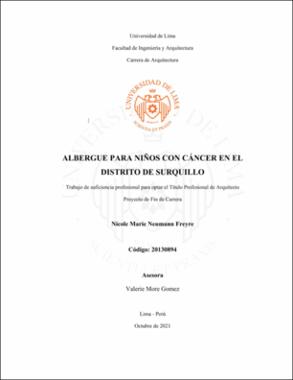Mostrar el registro sencillo del ítem
Albergue para niños con cáncer en el distrito de Surquillo
| dc.contributor.advisor | More Gómez, Valerie | |
| dc.contributor.author | Neumann Freyre, Nicole Marie | |
| dc.date.accessioned | 2022-07-12T21:14:54Z | |
| dc.date.available | 2022-07-12T21:14:54Z | |
| dc.date.issued | 2021 | |
| dc.identifier.citation | Neumann Freyre, N. M. (2021) Albergue para niños con cáncer en el distrito de Surquillo [Trabajo de suficiencia profesional para optar el Título Profesional de Arquitecto, Universidad de Lima]. Repositorio Institucional de la Universidad de Lima. https://hdl.handle.net/20.500.12724/16136 | es_PE |
| dc.identifier.uri | https://hdl.handle.net/20.500.12724/16136 | |
| dc.description.abstract | El cáncer es una enfermedad que se puede presenciar en la vida de cualquier persona de un momento para otro, afectando gravemente su salud, como su rutina diaria. A pesar que el cáncer es considerado la segunda causa de muerte a nivel mundial, en el Perú existe una falta de centros oncológicos para personas de un perfil socioeconómico bajo. Lima, que es la ciudad que más casos presenta, únicamente cuenta con un instituto a nivel nacional, que es el INEN (Instituto Nacional de Enfermedades Neoplásicas), donde tratan a personas de bajo recursos, principalmente que cuentan con seguro SIS. Es por esto que, la mayoría de personas de otras regiones, que principalmente son de bajo recurso, migran a la capital para poder recibir tratamiento en el INEN. La problemática principal radica en que estas personas que migran no disponen de un lugar para vivir en Lima, durante el tiempo que dure su tratamiento y usan el exterior del INEN como su “hogar”; donde el principal afectado es el niño, que es el mayor gasto económico para las familias, donde al menos un familiar debe acompañarlo en el proceso. Por otro lado, los albergues existentes son escasos y la mayoría son casas adaptadas que se encuentran en malas condiciones con mala iluminación, falta de espacio, acumulación de pertenencias y hacinamiento. Por este motivo, se plantea el desarrollo de un albergue para niños con cáncer y un acompañante, donde se busca que el niño se sienta como en casa y pueda seguir con una rutina diaria básica. Se busca generar vínculos de interacción social mediante áreas de juego y áreas verdes como espacios intermedios; y además, brindar espacios de terapias alternativas que apoyen en la recuperación del niño, brindando distintos beneficios, físicos como psicológicos, y a su vez, a la reducción de estrés, del dolor y posibles casos de depresión. | es_PE |
| dc.description.abstract | Cancer is a disease that can appear in the life of any person from one moment to another, seriously affecting their health, as well as their daily routine. Although cancer is the second cause of death worldwide, in Peru there is a lack of cancer centers for people with a low socioeconomic profile. Lima, which is the city that presents the most cases, only has one institute at the national level. This institute is called INEN (National Institute of Neoplastic Diseases) and here, they treat low-income people. This situation is why the majority of people from other regions, who mainly have a low-income, migrate to the capital in order to receive treatment at the INEN. The main problem lies in the fact that these people that migrate do not have a place to live in Lima during the duration of their treatment and they use the exterior of the INEN as their “home”. The main effect occurs to children, which are the greatest expense for families, as at least one relative must accompany them in the process. On the other hand, the existing shelters are scarce and most are adapted houses that are in poor condition with poor lighting, lack of space, accumulation of belongings and overcrowding. For this reason, I propose the development of one dedicated shelter for children with cancer and his companion. For this reason, it’s proposed the development of a shelter for children with cancer and his unique companion. This shelter development proposal will help the child feel at home, for example following a basic routine. This shelter will generate links of social interaction through play areas and green areas as intermediate spaces. It will also provide space for alternative therapies, providing different physical and psycological benefits which can help reduce stress, pain and depression | en_EN |
| dc.format | application/pdf | |
| dc.language.iso | spa | |
| dc.publisher | Universidad de Lima | |
| dc.rights | info:eu-repo/semantics/openAccess | * |
| dc.rights.uri | https://creativecommons.org/licenses/by-nc-sa/4.0/ | * |
| dc.source | Repositorio Institucional - Ulima | |
| dc.source | Universidad de Lima | |
| dc.subject | Children´s shelters | en_EN |
| dc.subject | Cancer in children | en_EN |
| dc.subject | Alberges infantiles | es_PE |
| dc.subject | Cáncer en niños | es_PE |
| dc.subject | Lima Metropolitana (Perú) | es_PE |
| dc.title | Albergue para niños con cáncer en el distrito de Surquillo | es_PE |
| dc.type | info:eu-repo/semantics/bachelorThesis | |
| thesis.degree.level | Título Profesional | |
| thesis.degree.discipline | Arquitectura | es_PE |
| thesis.degree.grantor | Universidad de Lima. Facultad de Ingeniería y Arquitectura | |
| dc.publisher.country | PE | |
| dc.type.other | Trabajo de suficiencia profesional | |
| thesis.degree.name | Arquitecto | |
| renati.discipline | 731026 | |
| dc.identifier.isni | 121541816 | |
| renati.author.dni | 76031373 | |
| renati.level | https://purl.org/pe-repo/renati/level#tituloProfesional | * |
| renati.juror | Zadel Velásquez, Vanessa Lucianna | |
| renati.juror | Iberico Barrera, Jaime Hugo | |
| renati.juror | Miranda Alvarado, Martin | |
| renati.type | https://purl.org/pe-repo/renati/type#trabajoDeSuficienciaProfesional | * |
| dc.subject.ocde | https://purl.org/pe-repo/ocde/ford#6.04.08 | |
| ulima.cat | OI |



